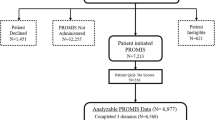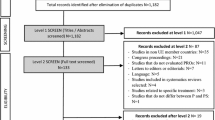Abstract
Patient-reported outcome measures (PROMs) capture disease severity metrics from the patient’s perspective, including health-related quality of life (HRQL). Disease-specific validation of PROMs improves their clinical utility. We evaluated construct validity (HRQL) for Skindex-16 in routinely seen psoriasis patients and characterized instances of discordance between Skindex-16 scores and clinician-reported outcome measure of disease severity. We retrospectively studied psoriasis patients seen by University of Utah Dermatology from 2016 to 2020. Cross-sectional construct validity was assessed using quantile regression and Spearman correlation between overall physician global assessment (OPGA) score and Skindex-16 scores. Longitudinal within-subject correlation was performed using linear mixed models. Discordance (10th percentile or lower OPGA and 90th percentile or higher Skindex-16 score [clear skin, poor HRQL; cspHRQL] or the reverse [severe skin, good HRQL; ssgHRQL]) was characterized descriptively. 681 first-visit patients with psoriasis were included. Median overall Skindex-16 score varied by ≥ 10 points across all levels of OPGA scores. OPGA and Skindex-16 domain scores were moderately correlated (emotions ρ = 0.54, functioning ρ = 0.47, and symptoms ρ = 53). Longitudinal correlations were similar (emotion ρxy = 0.54, functioning ρxy = 0.65, symptoms ρxy = 0.47). Visits with cspHRQL discordance occurred for each Skindex-16 domain (emotions = 7, functioning = 13, symptoms = 12). The ssgHRQL group was observed within the emotions (n = 1) and functioning (n = 23) domains. Median Skindex-16 scores are different between different levels of OPGA and show moderate cross-sectional and longitudinal correlation. This supports construct validity in patients with psoriasis. Severe discordance was rare and most often for those with clear skin but poor HRQL. These discordances can prompt further patient–clinician conversation.

Similar content being viewed by others
Data availability statement
Datasets related to this article are available upon request.
References
Greenhalgh J (2009) The applications of PROs in clinical practice: what are they, do they work, and why? Qual Life Res 18(1):115–123
Schäfer I, Hansen H, Schön G, Höfels S, Altiner A, Dahlhaus A et al (2012) The influence of age, gender and socio-economic status on multimorbidity patterns in primary care. First results from the multicare cohort study. BMC Health Serv Res 12:89
von dem Knesebeck O, Bickel H, Fuchs A, Gensichen J, Höfels S, Riedel-Heller SG et al (2015) Social inequalities in patient-reported outcomes among older multimorbid patients–results of the MultiCare cohort study. Int J Equity Health 7(14):17
Kozlov N, Benzon HT (2020) Role of gender and race in patient-reported outcomes and satisfaction. Anesthesiol Clin 38(2):417–431
Carr E, Mahil SK, Brailean A, Dasandi T, Pink AE, Barker JN et al (2021) Association of patient mental health status with the level of agreement between patient and physician ratings of psoriasis severity. JAMA Dermatol 157(4):413–420
Barry MJ, Edgman-Levitan S (2012) Shared decision making–pinnacle of patient-centered care. N Engl J Med 366(9):780–781
Marshall S, Haywood K, Fitzpatrick R (2006) Impact of patient-reported outcome measures on routine practice: a structured review. J Eval Clin Pract 12(5):559–568
Denis F, Lethrosne C, Pourel N, Molinier O, Pointreau Y, Domont J et al (2017) Randomized trial comparing a web-mediated follow-up with routine surveillance in lung cancer patients. J Natl Cancer Inst 109(9):djx029
Taliercio VL, Snyder AM, Biggs AM, Kean J, Hess R, Duffin KC et al (2021) Clinicians’ perspectives on the integration of electronic patient-reported outcomes into dermatology clinics: a qualitative study. Qual Life Res 31:1719–1725
Pattinson RL, Trialonis-Suthakharan N, Gupta S, Henry AL, Lavallée JF, Otten M et al (2021) Patient-reported outcome measures in dermatology: a systematic review. Acta Derm Venereol 101(9):adv00559
Taliercio V, Langner AU, Secrest AM, Duffin KC (2022) Assessing psoriasis severity: Psychometric validation of overall physician global assessment. J Am Acad Dermatol 86(3):637–638
Feldman SR, Krueger GG (2005) Psoriasis assessment tools in clinical trials. Ann Rheum Dis 64(Suppl 2):ii65-68 (discussion ii69–73)
Rencz F, Gulácsi L, Péntek M, Poór AK, Sárdy M, Holló P et al (2018) Proposal of a new scoring formula for the Dermatology Life Quality Index in psoriasis. Br J Dermatol 179(5):1102–1108
Rencz F, Gulácsi L, Péntek M, Szegedi A, Remenyik É, Bata-Csörgő Z et al (2020) DLQI-R scoring improves the discriminatory power of the Dermatology Life Quality Index in patients with psoriasis, pemphigus and morphea. Br J Dermatol 182(5):1167–1175
Barbieri JS, Gelfand JM (2021) Patient-reported outcome measures as complementary information to clinician-reported outcome measures in patients with psoriasis. JAMA Dermatol 157(10):1236
Szabó Á, Brodszky V, Rencz F (2021) A comparative study on the measurement properties of Dermatology Life Quality Index (DLQI), DLQI-relevant and Skindex-16. Br J Dermatol 24:bjd20765
Gergely LH, Gáspár K, Brodszky V, Kinyó Á, Szegedi A, Remenyik É et al (2020) Validity of EQ-5D-5L, Skindex-16, DLQI and DLQI-R in patients with hidradenitis suppurativa. J Eur Acad Dermatol Venereol JEADV 34(11):2584–2592
Hornsey S, Stuart B, Muller I, Layton AM, Morrison L, King J et al (2021) Patient-reported outcome measures for acne: a mixed-methods validation study (acne PROMs). BMJ Open 11(3):e034047
Paudyal P, Apfelbacher C, Jones C, Siddiqui S, El-Turki A, DeGiovanni C et al (2020) “DLQI seems to be ‘action’, and Skindex-29 seems to be ‘emotion’”: qualitative study of the perceptions of patients with psoriasis or eczema on two common dermatology-specific quality of life measures. Acta Derm Venereol 100(8):adv00105
Cappelleri JC, Zou KH, Bushmakin AG, Alvir JMJ, Alemayehu D, Symonds T (2014) Patient-reported outcomes: measurement, implementation and interpretation. CRC Press, Boca Raton, p 331 (Chapman & Hall/CRC biostatistics series)
Callis Duffin K, Gottlieb AB, Merola JF, Latella J, Garg A, Armstrong AW (2017) Defining outcome measures for psoriasis: the IDEOM report from the GRAPPA 2016 annual meeting. J Rheumatol 44(5):701–702
Chren MM, Lasek RJ, Sahay AP, Sands LP (2001) Measurement properties of Skindex-16: a brief quality-of-life measure for patients with skin diseases. J Cutan Med Surg 5(2):105–110
Ringash J, O’Sullivan B, Bezjak A, Redelmeier DA (2007) Interpreting clinically significant changes in patient-reported outcomes. Cancer 110(1):196–202
Fernandez-Peñas P, Jones-Caballero M, Espallardo O, García-Díez A (2012) Comparison of Skindex-29, Dermatology Life Quality Index, psoriasis disability index and medical outcome study short form 36 in patients with mild to severe psoriasis: quality of life in psoriasis. Br J Dermatol 166(4):884–887
Terwee CB, Bot SDM, de Boer MR, van der Windt DAWM, Knol DL, Dekker J et al (2007) Quality criteria were proposed for measurement properties of health status questionnaires. J Clin Epidemiol 60(1):34–42
Hamlett A, Ryan L, Serrano-Trespalacios P, Wolfinger R (2003) Mixed models for assessing correlation in the presence of replication. J Air Waste Manag Assoc 53(4):442–450
Shan G, Zhang H, Jiang T (2020) Correlation coefficients for a study with repeated measures. Comput Math Methods Med 2020:7398324
King MT (2011) A point of minimal important difference (MID): a critique of terminology and methods. Expert Rev Pharmacoecon Outcomes Res 11(2):171–184
Fortune DG, Richards HL, Griffiths CEM, Main CJ (2002) Psychological stress, distress and disability in patients with psoriasis: consensus and variation in the contribution of illness perceptions, coping and alexithymia. Br J Clin Psychol 41(Pt 2):157–174
Fortune DG, Richards HL, Main CJ, Griffiths CEM (2000) Pathological worrying, illness perceptions and disease severity in patients with psoriasis. Br J Health Psychol 5(1):71–82
Fortune DG, Richards HL, Kirby B, McElhone K, Main CJ, Griffiths CEM (2004) Successful treatment of psoriasis improves psoriasis-specific but not more general aspects of patients’ well-being. Br J Dermatol 151(6):1219–1226
Szabó Á, Brodszky V, Rencz F (2021) A comparative study on the measurement properties of DLQI, DLQI‐R and Skindex‐16. Br J Dermatol b20765
Schmitt-Egenolf M (2016) Physical activity and lifestyle improvement in the management of psoriasis. Br J Dermatol 175(3):452–453
Russo PAJ, Ilchef R, Cooper AJ (2004) Psychiatric morbidity in psoriasis: a review. Australas J Dermatol 45(3):155–159 (quiz 160–1)
Henry AL, Chisholm A, Carter LA, Bundy C, Griffiths CEM, Kyle SD (2020) The relationship between sleep disturbance, symptoms and daytime functioning in psoriasis: a prospective study integrating actigraphy and experience sampling methodology. Sleep Med 72:144–149
Basch E, Deal AM, Kris MG, Scher HI, Hudis CA, Sabbatini P et al (2016) Symptom monitoring with patient-reported outcomes during routine cancer treatment: a randomized controlled trial. J Clin Oncol Off J Am Soc Clin Oncol 34(6):557–565
Mierzynska J, Piccinin C, Pe M, Martinelli F, Gotay C, Coens C et al (2019) Prognostic value of patient-reported outcomes from international randomised clinical trials on cancer: a systematic review. Lancet Oncol 20(12):e685–e698
Secrest AM, Chren MM, Hopkins ZH, Chen SC, Ferris LK, Hess R (2019) Benefits of electronically capturing patient-reported outcomes in dermatology for patient care. Br J Dermatol 181:826–827
Secrest AM, Hopkins ZH, Frost ZE, Taliercio VL, Edwards LD, Biber JE et al (2020) Quality of life assessed using Skindex-16 scores among patients with acne receiving isotretinoin treatment. JAMA Dermatol 156:1098
Joseph A, Prasad S, Hynan LS, Chren MM, Chong B (2021) Differences in quality of life in patients with cutaneous lupus erythematosus with varying income levels. Lupus 30(6):972–980
Funding
None.
Author information
Authors and Affiliations
Contributions
AMS, VT, AS, KD, RH: Conceptualization VT, ZHH, GS, AS: Methodology, Software VT, ZH, AMS: Data curation GK, VT, AS, ZHH, AMS: Writing- Original draft preparation, Visualization AMS, KD, RH: Supervision GK, ZHH, VT, AS, GS, KD, RH, AMS: Writing- Reviewing and Editing,
Corresponding author
Ethics declarations
Conflict of interest
Authors ZH Hopkins, G Kuceki, AM Snyder, VL Taliercio, GJ Stoddard, KC Duffin, R Hess have no relevant conflicts of interest to disclose. AM Secrest has received support from a Public Health Career Development Award from the Dermatology Foundation.
IRB
This study was approved by the University of Utah Institutional Review Board (#76927).
Additional information
Publisher's Note
Springer Nature remains neutral with regard to jurisdictional claims in published maps and institutional affiliations.
Rights and permissions
Springer Nature or its licensor (e.g. a society or other partner) holds exclusive rights to this article under a publishing agreement with the author(s) or other rightsholder(s); author self-archiving of the accepted manuscript version of this article is solely governed by the terms of such publishing agreement and applicable law.
About this article
Cite this article
Hopkins, Z.H., Kuceki, G., Taliercio, V.L. et al. Evaluation of Skindex-16 construct validity in routinely collected psoriasis data: a retrospective analysis of the relationship between overall physician global assessment scores and Skindex-16 and measure discordance. Arch Dermatol Res 315, 1151–1159 (2023). https://doi.org/10.1007/s00403-022-02491-4
Received:
Revised:
Accepted:
Published:
Issue Date:
DOI: https://doi.org/10.1007/s00403-022-02491-4




